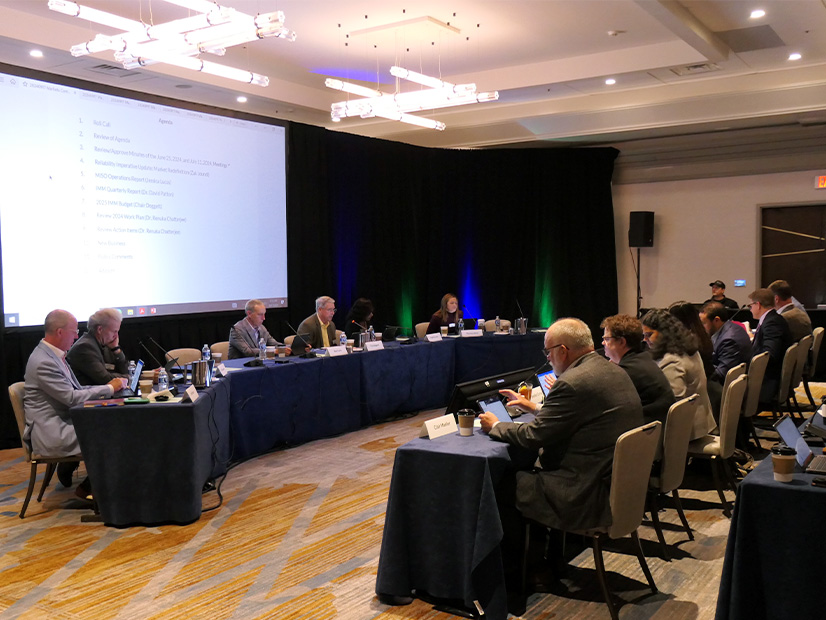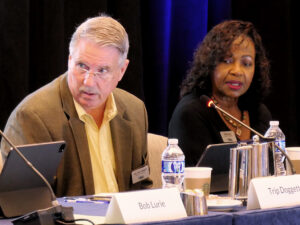INDIANAPOLIS — MISO said it managed a milder summer overall compared to previous years, though it weathered two hurricanes and escalated into emergency warnings during a heat wave.
MISO served its summertime peak of 122 GW on Aug. 26, using two maximum generation warnings as the Midwest baked under a prolonged heat wave. (See Late August Heat Wave Delivers 122-GW MISO Summer Peak.) Otherwise, summer brought an 85-GW average load, closely following the average load of the three previous summers.
MISO’s average $28/MWh real-time price throughout the season tracked cheap, $2/MMBtu coal and gas prices. The RTO experienced about 31 GW of daily generation outages and derates, lower than in previous years.
At a Sept. 17 Markets Committee of the MISO Board of Directors, Independent Market Monitor David Patton said MISO’s summer peak would have been about 1.8 GW higher without voluntary demand response in the footprint.
MISO’s board members and leadership praised operators for pulling through the overnight electrical island caused by Hurricane Beryl in early July. (See MISO: Hurricane Beryl Caused Electrical Island in Texas.)
“It’s hard to believe it’s been a while since we’ve been here, about three years,” Executive Director of System Operations Jessica Lucas said about delivering a hurricane operations post mortem. She said MISO prepared for an above-normal hurricane season, but so far, storms have been scarce.
Lucas said the Category 1 Beryl nevertheless caused the loss of 73 MISO-operated lines and 250,000 customer outages, a “surprising” number for a “low-intensity” storm.
MISO reported all but one of the lines leading to a Southeast Texas load pocket knocked out of commission. Eventually, the remaining in-service line — a tie line with SPP — went down as well July 8. Prior to the final outage, MISO noticed more generation available in the load pocket than load to serve, leading it to direct all but one generator offline. MISO kept flows on the line at essentially zero to limit potential customer impacts. MISO was prescient to do so, Lucas said, because that remaining line eventually went out of service.
Lucas said she had the “privilege” of being in MISO’s Little Rock, Ark., control room during the night to see firsthand how MISO, SPP and Entergy coordinated to resync the area to the bulk electric system.
“Operating an island for over eight hours is quite a trick. One of my colleagues said it’s like spinning a plate on a needle,” Vice President of Operations Renuka Chatterjee said.
MISO Director Trip Doggett said the feat was the result of “heroic effort.”
“I thought MISO did an amazing job of managing reliability during this event,” Patton said. However, Patton added that southeastern Texas “by far” experiences the most load shedding in MISO.
Patton suggested that MISO “take a hard look at its capacity zones” and consider splitting up MISO’s Zone 9, which contains Louisiana and southeastern Texas. He said the large zone and Louisiana’s capacity-sufficient status mask the fact that southeastern Texas needs resources.
“It prevents the market from signaling that MISO needs to build more generation in this area,” Patton said of the size of the zone.
MISO South’s second hurricane over summer proved more uneventful, Lucas said.
MISO declared conservative operations Sept. 10-13 for its South region as Hurricane Francine made landfall in Terrebonne Parish on Sept. 11 with Category 2 force. At the time, Entergy reported upward of 300,000 customer outages. By Sept. 16, Entergy reported it restored nearly all customers in Louisiana and Mississippi.
“There was not nearly as much excitement as Beryl caused,” Lucas said.
Lucas also noted operators navigated a “wind drought” lasting 11 hours July 21 and eight hours July 22 among its 31-GW wind fleet.
MISO defines wind droughts as periods during which wind output dies down to 500 MW or less for five or more hours. MISO said it has experienced 11 such events since 2020.
“As more weather-dependent resources are added to the portfolio, managing long-term, multiday resource droughts will be a challenge,” Lucas said.
IMM Demands Tougher Demand Response Requirements
Despite summer 2024’s lack of emergencies, Patton used his time slot for a summertime review to ask MISO to “beef up” testing to make sure load-modifying resources can deliver what they promise.
“So much of what we pay for demand response resources has turned out to be manipulative, or not useful to the system,” Patton said.
Patton said a review of MISO’s demand response showed that up to 25% of DR resources submit “mock tests” for their accreditation in lieu of real testing, which presents opportunities for fraudulent data submissions.
Patton said the review also uncovered one commercial retail end-use customer signed up with multiple market participants for the same load and some “unconsummated contracts with critical information redacted that prevent MISO verifying the DR amount or validity.”
Patton also said MISO should stop allowing load-modifying resources to cross-register as both capacity resources and emergency demand response. He said resources should commit to selling one or other, or better yet, MISO should eliminate its emergency demand response program. He pointed out MISO never actually has called on emergency demand response.
Patton’s suggestions come after multiple demand response resources in MISO have been disciplined for deceptive behavior.
Over the past two years, FERC has caught three companies manipulating MISO’s demand response market and collecting unwarranted payments. The commission found that an air separation facility in Indiana accepted payments for fictitious load reductions, an Arkansas steel mill made phony use reductions spanning years, and that an obscure, Texas-based LLC formed to sell in-car ketchup holders fraudulently enrolled customers and made bogus DR offers in three capacity auctions. (See FERC Catches Ketchup Caddy Co. in Another Fake DR Scheme in MISO.)




